Here are even more reviews of Streamline Pictures’ video releases. These are being posted mainly for my reference purposes, but they should be of interest as they recall some of the earliest serious commentary about anime published back in the 1990s.
Great Conquest: Romance of the Three Kingdoms
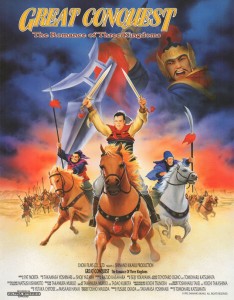
“The Chinese, by and large, look upon history as a series of cycles which is reflected within their culture by various changes in political, philosophical, religious, and/or military thought. The second century A.D. was the cusp of one of these great changes, when the old dynasty of the later Han Emperors began to be swept away.” “While there is a good amount of dialogue and character development in the movie, fans of action, blood, and fighting will not be disappointed. This film, if it were live-action, would be classified as a martial arts film. In fact, it is a Japanese animated Chinese historical drama, much the same as Like the Clouds, Like the Wind. The English dubbing, music, and production quality of Great Conquest are much better than in any ‘martial arts’ film, and indeed better than in many of Hollywood’s animated or live-action efforts.
“The script is perfect, reflecting the cultural and other personal traits of the Chinese people of that epoch; Pat Morita’s narration is unobtrusive and adds an even greater dimension of depth to the story that otherwise might be lacking. His voice, like those of various other voice actors in Great Conquest, rings of nobility and strength, the perfect qualities that we associate with the heroes of this film. While the running time of 118 minutes may be a bit much for viewers who have been trained to have ninety minute attention spans, not a moment is wasted. You will be drawn deeply into this epic struggle of true patriots, rebels, saints, and thieves, and learn to care for the characters. When the ending comes, you will cry for more. The quality of the animation, while not the most fluid, gives the feeling of viewing a historical panorama little by little. The movement of both horses and men, which has been lacking in numerous other animated films, is directed almost to perfection in Great Conquest. The overall production quality is very high, making Great Conquest one of the finest historical films ever produced. It would make a good introduction for school-aged young adults to Chinese history, and should be included in culturally diversified history class curriculums. Extra points are awarded for the superb close-captioning of this wonderful piece. Scores: Animation Quality: 9. Design & Production: 9. Story: 10. Music: 9. Voice Acting: 10. Overall Rating: 9 – Excellent.”
unsigned, Persistence of Vision, #1, June 1995, pg. 11.
Lapüta: Castle in the Sky

“Strictly an unknown quantity, ‘Laputa: Castle in the Sky’ is a Japanese animated film aimed at general audiences. What is known is that it has some problems. Not only is ‘Laputa’ playing the same weekend major studios are opening with three highly publicized, early entrants in the year-end holiday season derby, but its short engagement of only three days doesn’t allow much time for word-of-mouth publicity. And, although the movie is lively and well-paced, its length (more than two hours) could leave the targeted audience of youngsters restless. But for now, put aside those drawbacks. Those looking for a family film suitable for most young children, could do a lot worse than take a chance on this one. […] The unrated film is suitable for all ages except for occasional gunplay violence that possibly could be too intense for some very young viewers.”
Dave DeNeal, The Bellingham [Wash.] Herald, November 14, 1990, pg. ?
“A brief passage out of Jonathan Swift’s ‘Gulliver’s Travels,’ describing a floating island in the sky called Laputa, inspired Japanese animator Hayao Miyazaki. What impresses you about the full-length animation ‘Laputa’ is the wrap-around intensity of the animator’s fantasy. Swift’s image is the trigger, but Miyazaki creates his own world out of the modest materials familiar to anyone who’s watched Saturday morning cartoons. His two juvenile heroes may look like kewpie dolls, with their bland round faces, but their adventures have the feverish bounce and texture of a waking dream. The plot erupts rather than unfolds, and it’s the sort of pure childish escapism in which whimsy mixes freely with recognizable fragments of conventional logic. […] Bullets fly and cannonshells explode in ‘Laputa,’ with massive destruction and enormous puffs of smoke, but the violence is cartoonishly harmless. Miyazaki keeps his imaginary world spinning with plenty of sparks, but he’s able to blend men-ace with a bucolic vision and cackling humor. An enormous robot from Laputa is a cartoon Frankenstein, scary and rather dim but also surprisingly gentle. In the battle for Laputa, the little girl herself unleashes the apocalypse as if in frustration at the grown-up evildoers, but her anger has the purging quality of myth and wish-fulfillment. The sky island explodes, but it also re-generates itself. ‘Laputa’ provides an interesting glimpse of Japanese pop culture. Although nominally a children’s entertainment, this well-crafted animation is also meant for grown-ups able to transport themselves back to their own childhood.”
Robert Garrett, Boston Globe, June 16, 1989, pg. ?
“Americans have seen little good animation from the Orient. Some may even believe animation from Hong Kong or Japan is inferior to the standards set by Walt Disney and his heirs. Those beliefs may change after viewing the oddly stunning ‘Laputa Castle in the Sky,’ a feature-length cartoon written and directed by Hayao Miyazaki.” “Although employing some of the oddly stylized conventions of Japanese cartooning — like rounded-eyed characters who look vaguely European — this richly detailed, hand-drawn film has the lushness of early Disney animation. And with some curiously quirky characters, it creates its own fantasy world.” “With ‘Laputa,’ released in 1986, Miyazaki showed a style that combines offbeat humor, the grand shootouts of ‘Star Wars’ and some lavish scenes of Mad magazine-style zeppelins floating through roiling skies. Even if the characters seem somewhat odd when they speak dubbed English, it is clear Japanese animators may do for the art what their electronics manufacturers did for that industry. American buffs may no longer scoff.”
Ernest Tucker, Chicago Sun-Times, April 21, 1989, pg. 35
“This spring, the best of Japanese animation began playing in America — uncut, faithfully translated into English, and presented on the big screen, starting with Streamline’s release of Laputa: The Castle in the Sky.” “Streamline’s first release, the action/adventure tale Laputa, involves two children, air pirates, government agents and the military searching for the legendary Laputa, a flying castle with great treasure and a terrifying secret. The movie is noteworthy for its lavish designs, special FX and stunts which would cost a fortune if filmed in live action.” “Laputa began its American run in March, but will be playing one theater at a time in select cities.”
Bob Miller, Comics Scene, #7, pg. 69
“Unquestionably the most impressive piece of Japanese animation yet to reach our shores, ‘Laputa’ is a beautifully wrought adventure for all ages. Although not as fluid as, say, ‘The Little Mermaid,’ ‘Laputa’ at its most eye-popping makes up for anything it may lack in litheness with gorgeous designs and a grand, action-packed imaginativeness that the reality-bound likes of ‘Star Wars’ and ‘Indiana Jones’ could never hope to match. […] Writer-director Hayao Miyazaki fills his story with breathless wonder, some lame but pleasant humor and even an ecologically conscious message. The craftsmanship here is of an order unfamiliar, yet thoroughly accessible, to Western eyes. Instead of the flat, uniform lighting we’re used to seeing in cartoons, ‘Laputa’ revels in textures, shadows and multiple depths. Even though the main characters are rendered in the saucer-eyed moppet style so beloved by Japanese animators, the strange landscapes and bizarre machinery they frolic through are so convincingly laid out, you sometimes forget you’re watching a cartoon. Unlike many Japanese imports, ‘Laputa’ relates its busy narrative coherently and dramatically. And it does what every good, full-length cartoon should: it constantly shows us stuff that no live-action film could approximate, breathing life into fantasy as only this art form can.”
Bob Strauss, [Los Angeles] Daily News, February 2, 1990, pg. 17
“In a review of a much-anticipated, full-length, animated film from Walt Disney Studios released last year, we made the mistake of comparing the less-than-memorable result to the unambitious cartoons churned out by the Japanese. The ink was barely dry before we began to receive calls and letters from irate aficionados of Japanese animation art, many of who were polite enough to point out that while much of the Japanese animation routinely shown on Saturday morning television is indeed substandard and static, there are also some extraordinary animated films being produced in that country, few of which make it to American shores. And now we have some indisputable evidence, in the form of Laputa, Castle in the Sky, an exquisitely crafted, honestly exciting fantasy adventure that manages to hold our attention for its entire two-hour running time, a length even Disney has never attempted. […] Original in conception and style, Laputa could take Japanese animation out of the basements and rec rooms where its admirers now congregate, and into the entertainment mainstream.
“Like the best fables, Laputa is able to establish quickly and deftly its own fantasy world, one that is vaguely Eastern European and that combines elements of the past, present and future. Taking a cue from Spielberg and Lucas, Miyazaki begins the film in full-throttle, with a band of air pirates, headed by a crotchety old woman named Dola, attacking an elaborate airship for the purpose of abducting a little girl named Sheeta, who is being held there against her will by mysterious men in sunglasses. […] the film’s final half-hour is revealed to be everything its advance hype indicated. Why the Japanese always insist on making the children-heroes of their films look like those big-eyed kids from greeting cards is beyond me, but except for the leads the rest of the animation in this film is remarkable, from the rich, brilliant landscapes and aerial views, to the wonderful mechanical inventions, which are part futuristic technology and part Rube Goldberg-contraptions. Miyazaki seems to have crafted the look of this film from a design primer of the past three decades; references to everything from Moebius to the French cartoonist Herge to the controversial H. R. Giger abound. And the island itself is truly something to behold, seemingly made up of equal parts of idyllic heaven and futuristic hell. Kids should absolutely love it, but so should a lot of grown-ups, especially those who loiter around fantasy-oriented bookshops. And even those of us who prefer a more human dimension to our escapist fare should find plenty to admire and appreciate. It may not be Disney, but in the case of Laputa, Castle in the Sky that’s a decided advantage.”
Terry Lawson, Dayton [Ohio] Daily News, September 2, 1989, pg. 4A
“There are scenes in Lapüta: Castle in the Sky in which the animation is so finely wrought, so masterful in its deployment of light and shadow, perspective and color, that you forget that what you’re watching is a cartoon. Roiling thunderclouds sail along a dusky horizon; white pigeons flap and flutter over an endless landscape patched with villages and farms; the camera pans deep down into narrow canyons, houses jutting from its craggy sepia walls — this is real-life in all its Spielbergian splendor, right? But then up pop those unmistakable Japanese cartoon faces: big, black saucer-eyes, the tiniest of noses, elfin ears and pixie mouths. And out come these incredible airships — all propellors and turrets and gunnery stations. And then come the robots and the villainous army platoons, and the airborne pirates led by a crusty old woman with red pigtails — a sort of geriatric Pippi Longstocking. It’s a cartoon, all right, and a doozy of one. Written and directed by veteran Japanese animator Hayao Miyazaki (and dubbed with considerable care into English), Laputa takes its inspiration from Jonathan Swift’s Gulliver’s Travels. In Swift’s fabulist satire, mention is made of a floating island called Laputa (LAP-yoo-ta) on which stands an elaborate castle and gardens. In Miyazaki’s animated feature, released in Japan in 1986, the flying island is at the center of a battle between forces of good and evil: two young orphans in the one corner, and thieves, secret agents and army generals in the other. (It’s a crowded corner.)
But Miyazaki is inspired too by more immediate sources than the 18th-century Swift — notably the European comic-strip art of Jean “Moebius” Giraud and Tintin creator Herge. The various flying machines in this all-ages adventure have that heavy metal, medieval-meets-tomorrow look to them that suggest the hovering futuro aircrafts designed by Moebius. And in their comical facial expressions (and facial hair covering half their mugs), the gruff (but ultimately lovable) pirates resemble various characters from Herge’s popular Tintin books. Its Western source-material notwithstanding, Laputa embodies the best of state-of-the-art Japanese animation. It is richly detailed (in both the drawings and the attention to the nuances of sound effects); the sky-high robots recall the Japanese TV series Robotech; and its two protagonists, the orphan girl Sheeta and the orphan boy Pazu, exude that innocent-and-valiant nobility unique to what’s come to be known as Japanimation. Aficionados of Japanese comic-book and cartoon art, and other fans of movie animation, are more than likely to enjoy this cliffhanger tale, but with a running time that goes beyond two hours, Laputa does begin to wear. Streamline Pictures, a new distribution unit whose purpose is to export Japanese animation features to a burgeoning U.S. cult market, promises to release these films un-cut, in quality dubbed versions. While this move should generally be applauded (previous stateside releases of Japanese animated flicks looked as if they had been edited with ginsu knives), some conscientious trimming — at least in the case of Laputa — should remain an option.”
(N.b.: this is the review of Streamline Pictures’ first release, after the company opened in October 1988.)
Steven Rea, Philadelphia Inquirer, March 24, 1989, pg. ?
“‘Laputa: The Castle in the Sky’ is an exceptional example of Japanese animation, though this one is primarily a film for children. […] ‘Laputa’ has moments of great charm mixed with major bouts of menace. Very young children might be frightened by the pirates, who turn out to have kind hearts. But most children will be awed by the imagination writer and director Hayao Miyazaki employs in this colorful and extremely well-made two-hour film.
Marylynn Uricchio, The Pittsburgh Post-Gazette, May 19, 1989, pg. ?
“The pluses outweigh the minuses in a surpising Japanese feature-length cartoon called ‘Laputa: The Castle in the Sky.’ Much more interesting graphically than many of the pretentiously artsy cartoons that turn up in the annual ‘Tournee of Animation,’ writer-director Hayao Miyazaki’s ‘Laputa’ is no cheap TV cartoon. It is a beautifully detailed, richly colored, almost literal cartoon comparable in quality to the early Disneys. And it makes a somewhat complicated plot, inspired by the works of Jonathan Swift, rather clear, if shorn of satirical implications. […] The story is pure sci-fi and not the sort I appreciate. And for an animated film, especially one with mostly unshaded characters, it runs on for an unbelievable two hours and four minutes. I was ready to grab Laputa, call in Muska and Dola and award it to the quickest bidder after about 75 minutes. But it never stops looking good, even if all the characters are inexplicably Caucasian and say things like ‘Let’s skeddadle.'”
Ed Blank, The Pittsburgh Press, May 26, 1989, pg. ?
“‘Laputa,’ an animated feature playing at the Sandmill Cinema in Santa Cruz this week, is a fine adventure story that features an improbable but plea-sing mix of elements. […] ‘Laputa’ (pronounced ‘Lap-pew-tah’) is very much a good-natured film — the pirates are commanded by a shrill, domineering, pig-tailed lady known as Mommy, who comes on tough but, of course, has a soft heart underneath. Indeed, the whole story, which revolves around two young people, Padzu and Sheeta, both seeking to unravel mysteries connected to their past, is underlayed with a generous dose of light humor, which balances out the action very well. The style of animation is instantly recognizable as Japanese; the dialog’s in English. The young hero and heroine look vaguely Caucasian, with button eyes and small, sharp noses; other characters (particularly Mommy and her pirate crew) are burlesques on European stock, with big noses, funny moustaches and voluminous appetites. The gadgets, meanwhile, are mind-boggling in their complexity, the action sequences are eye-poppers, and the scenery itself looks very, very three-dimensional. The Japanese, both young and old, consume this kind of entertainment (known as manga) by the truckload, in the form of both video and comic books. Any kid who liked ‘Star Wars,’ the Muppet films, or ‘Treasure Island’ will get a real kick out of this one. Kids over 30 will, too.”
Jeff Hudson, Register-Pajaronian [Watsonville, CA]. September 28, 1989, pg. A18
“At one point in ‘Laputa,’ when a military and pirate airship are racing through layers and fissures of cloud to reach a hidden treasure in the sky, the shadow of the pirate ship — surrounded by a faint rainbow halo — moves over a changing cloud cover below. It’s just one small detail in the magnificent canvas that makes up this fast-paced and visually stunning feature-length cartoon. ‘Lapüta, Castle in the Sky’ is the first offering from Streamline Pictures, a recently formed presenter of Japanese animated films, big-budget extravaganzas aimed at a sophisticated audience. […] ‘Lapüta,’ at two hours running time, never has a dull moment. It moves right along and whets the appetite for more from the same source.”
Michael Upchurch, The Seattle Times, May 31, 1989, pg. G5
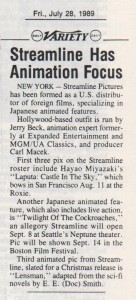
A news item from VARIETY announcing the existence of Streamline Pictures – from 1989 (click to enlarge)
“‘Laputa: Castle in the Sky’ is a frequently astounding animated feature from Japan. Written and directed by Hayao Miyazaki, it is an imaginative extrapolation of a reference in Jonathan Swift’s ‘Gulliver’s Travels’ to Laputa, a floating island-city hovering over Balnibarbi. Miyazaki uses that to spin off a modernistic sci-fi fable with a subtle ecological message that is delivered only after two hours of Indiana Jones-style adventure. […] Miyazaki’s world, so full of color and life, is always just across the borderline of imagination, its acute details softened by clouds and shadows, its principles revealed by actions more than words. It’s full of ‘Star Wars’-style confrontation, but it’s also nice to see it handled on equal terms by male and female protagonists. ‘Laputa’ should appeal to both children and adults; neither group is likely to mind its two-hour length. That’s really a testament to Miyazaki’s skill as both story-teller and animator; his approach is always cinematic in a medium that’s often dismissed. Many of today’s Saturday morning and weekday afternoon cartoons are cheaply produced in Japan, but the sophisticated ‘Laputa’ is far superior to them in all its production values and is one of the first big-budget animated films from Japan to receive major exposure here. Ironically, it’s not visibly ‘Japanese’: The film is dubbed in English and all the characters are European-looking. ‘Laputa’ has resonance and complexity; it makes one eager for the next Japanimation feature […]”
Richard Harrington, The Washington Post, September 2, 1989, pg. C2
“Although I saw ‘Laputa: Castle in the Sky’ in an art theater in San Francisco over a year ago, the incredible story-line and fantastic visuals are still clear in my mind. This movie would have given Batman a run for its money in 1989 if it weren’t an obscure foreign film translated into English and only played in art theaters. It’s that good. There are few movies I have come across in life that I would recommend to anyone, no matter what their age, status or tastes. ‘Star Wars’ was such a film. ‘Laputa: Castle in the Sky’ is also. Although there is little similarity between the two movies, the overwhelming, all absorbing awe that takes hold of a viewer watching it the first time is the same. […] Although Miyazaki has created an amazing, fictitious reality, it is completely believable and absorbing. The only criticisms I have of the film are the running time, which, at two hours, seemed a little long, and a few of the mood swings in the movie. The light-hearted nature of some of the opening scenes and a few later scenes of extreme tension and destruction didn’t seem to belong in the same movie. But these minor hang-ups in no way com-promise the grandeur of the animation or the enthralling story development. Both of which seemed like opiates of the eyes and mind.”
Scott Ryan, The [Seattle] Western Front, November 14, 1990, pg. 12
Next week: Still more reviews


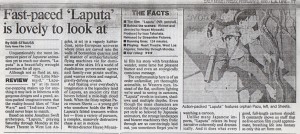
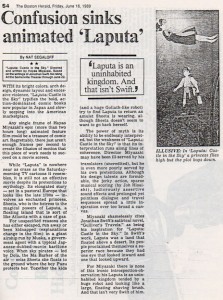
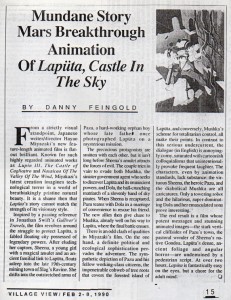
 Fred Patten (1940-2018) was an internationally respected comics and animation historian. He has written about anime or comic books for publications ranging from Animation Magazine and Alter Ego to Starlog. He was a contributor to The Animated Movie Guide (2005), and is author of Watching Anime, Reading Manga (2004, Stone Bridge Press), a collection of his best essays, and Funny Animals and More (2014, Theme Park Press), based upon his early columns here on Cartoon Research. He passed away on November 12th, 2018.
Fred Patten (1940-2018) was an internationally respected comics and animation historian. He has written about anime or comic books for publications ranging from Animation Magazine and Alter Ego to Starlog. He was a contributor to The Animated Movie Guide (2005), and is author of Watching Anime, Reading Manga (2004, Stone Bridge Press), a collection of his best essays, and Funny Animals and More (2014, Theme Park Press), based upon his early columns here on Cartoon Research. He passed away on November 12th, 2018.





































The first review, of “Great Conquest”, mentions “Like the Clouds, Like the Wind”. Did anyone ever release this made-for-TV movie in America? Streamline tried to get it, but this was one of the too-expensive titles. I’ll cover it in a future column.
Boy, how many things are wrong in the Boston Herald’s review of “Laputa”? The reviewer doesn’t know the difference between an animated film or TV program and a comic book; neither Sheeta nor the flying city are supposed to have “magical powers”; the airship on which Sheeta and Muska are passengers at the beginning of “Laputa” is not “run by Muska”; …
That is very repulsive to read. Was it really hard for that guy to follow the movie?
Well, how about the L.A. critic who keeps calling the female lead “Sheena”? Now, THIS is Sheena…http://imgur.com/HRvE7T7
BTW Fred, while I don’t know if you’ve ever kept such records or not pertaining to which theaters/locations Streamline’s releases were sent to, I don’t suppose if you remember if any of these managed to make their way to my neck of the woods? (Toledo, OH) I’m sure they didn’t, but I do recall hearing someone tell me he remembers seeing Akira once in 1990 somewhere in town.
Jerry Beck would have to answer that question. I only copied the records for the first bookings of Streamline’s titles.
Great Conquest wasn’t TOO bad for a dub by Streamline, but the ’80s version of Laputa was terrible. Compared to even today’s dubbing, it sounds very emotionally devoid and robotic, with no one turning in the way of memorable performances. The scripting was terrible as well; lots of choppy-sounding phrases and lines throughout. That said, I know Macek and company had nothing to do with that particular dub. It was clearly dubbed on the cheap.
Disney’s version is much better overall, despite the leads sounding more like teenagers and the script being a bit more talkier, the performances are stronger, and of course it helps that Mark Hamill and Cloris Leachman steal the show.
Since Streamline wasn’t behind the first Castle in the Sky English dub, why even make the comparison? Personally, like Carl Macek, I think it was okay. It suffers from a low budget and some of the supporting character voices are weird, but the performances are good overall and I can listen to it without my enjoyment of the film being affected.
I think the Disney dub is okay too. For me, the Tokuma dub suffers from being underproduced and the Disney dub suffers from being overproduced. I also can’t say I’m a fan of the leads in the Disney dub, but other cast members turn in good performances.
I haven’t seen Great Conquest, but saying it “wasn’t TOO bad for a dub by Streamline” sounds like a backhanded compliment that’s uncalled for IMO. If you’re not a fan of Streamline’s dub, these articles aren’t for you.